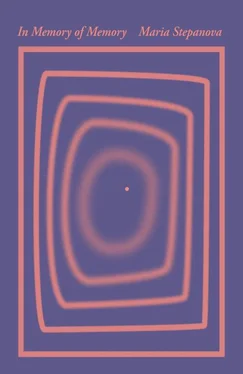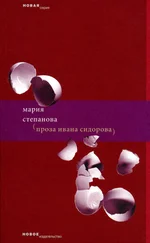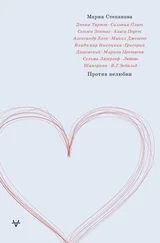Her gaze had a very direct purpose to it: between the woman and her witness something was happening, or was going to happen. Strictly speaking, her stare was already that happening: it was the conduit or the corridor; the black hole. Her face was wide, flat, with slits for eyes, and there was nothing else in it apart from the intensity of the stare. Her communication was intended for the bearer of the photo, but I had somehow taken his place, and this made the situation both tragic and absurd. It was so very obvious that The Lady On The Leather Sofa (unlike the whole of art and the whole of history, which was definitely intended for me and took me into account) didn’t have me in mind as a viewer, didn’t want me, and I knew with certainty that someone else should have been in my place, someone with a name and a surname, and possibly even a mustache.
The absence of this other viewer made the whole thing feel indecent, coitus interruptus in its most basic sense, and I was the one interrupting. I’d turned up at the wrong time, and in the wrong place, and I’d witnessed what I shouldn’t have witnessed: sex. The sex was not in the body or the pose, or even the surroundings (although I remember them well) — it was in the directness of the gaze, its lack of ambiguity, the way it paid no attention to anything beyond the scene. Strange when you think that even thirty years ago both participants were probably dead and most certainly are now. They have died and left the sex act orphaned in an empty room.
*
What do I have against images? Perhaps it is that they all have the same flaw: euphoric amnesia. They no longer remember what they signify, where they came from, who they are related to, and yet none of this bothers them. For the beholder (I no longer know whether to call her a reader or a viewer) the picture seems to do more, to serve better. It delivers its message quicker, without wasting words, never tiring of actively engaging with the message: to stun us, to grasp hold of us, to occupy our thoughts. The picture seduces with its illusion of economy: as text begins to unwind its first phrases, a photograph has already come, confounded, conquered — and then it graciously condescends to allow the text to speak, to add the inessentials of what happened, and where.
For a whole century now the overproduction of visual material has been called the problem of the age, and its defining sign: heavy carts of descriptive text, loaded with meaning, have been overtaken by the image’s swift sleighs. It’s doubtless true, even if the sleighs only appear swifter to begin with. It’s not just the dead who disappear in the mirrored corridor of reproduction — the living do, too. Siegfried Kracauer describes the process with photographic precision in his essay on photography: we can break down what our attention does to a photo of our grandmother into its various phases, how she literally disappears before us, vanishes into the folds of her crinoline, leaving only a collar, a chignon, and a skirt bustle on the surface of the image.
The same thing happens to us. With every new selfie we take, every group shot or passport photo, our lives become arranged into a chain of images, a history that is quite different from the one we tell ourselves and want others to believe. The line of was-and-will-be, a compendium of single moments, poses, mouths open to speak, blurry chins, none of which we chose ourselves. Balzac foresaw some of this and refused to have his photograph taken, reflecting that each new picture removed a layer of balzac , pared it away, and if you let it happen, soon nothing would be left of you (or what would be left was only a puff of smoke, the vegetable heart, and the very last layer, the thickness of a death mask).
The mechanics of photography never intended to preserve the essence. The project of photography better resembles those time capsules intended for our descendants, or for aliens from outer space, filled with evidence of humanity: an anthology of our greatest moments an attempt to define ourselves through our civilization’s crowning achievements — Shakespeare/Mona Lisa/cigar, or penicillin/iPhone/Kalashnikov. They remind me of Egyptian burial sites, expanding suitcases stuffed with life’s essentials. If we imagine our descendants or the aliens to be curious, and this curiosity to be unlimited by time, then it will only be satisfied by a bank of infinite images, a cupboard where everything is packed away, every last person’s every last moment. And if this terrifying documentary mass could be gathered and kept ready for use, it would hardly be different from the incomplete but ever-increasing mass of data kept somewhere in the shapeless pockets of the atmosphere and called into being by the twitch of a computer mouse.
Photography observes change first and foremost — and always the same change: growth becoming dissolution and disappearance. I’ve seen a few photography projects that have documented change over decades, they flash up on social media now and again, giving rise to a bittersweet tenderness, and the almost improper curiosity with which young, healthy people regard a future that hasn’t even dawned for them yet. A young Japanese man takes a photograph of himself with his young son. Time passes, the boy is one, four, then twelve years old, then twenty: it’s like speeded-up film — we watch one being fill with life, as a balloon fills with air, while the other being diminishes and creases; its light gutters. Or another: Australian sisters who take a picture of themselves every year over a period of forty years in the same room, same spot, and in every picture they age a little more, slowly resigning themselves to aging and to those tiny visible signals of their eventual demise. In this sense at least, art’s endeavor is diametrically opposed to photography: any successful body of text is a chronicle of growth, a thing that is not completely in line with the parallel chronology of the appearance of wrinkles and pigmentation spots. Photography is less compromising: knowing none of this will survive, it makes its best attempt at preservation.
I’m talking about a particular kind of photography here. It’s no coincidence that it’s the most widespread, tracing its chalk circle around both professional photojournalists, amateurs with their mobile phones, and much that lies between these extremes. These photographers (and their viewers) are united by an unwavering belief in the photograph as document, witnessing reality, grasping it as it really is, without any kind of literary ornamentation: a rose is a rose is a rose. Art photography, in its aim to bend and reconstruct the visible world in the name of individual perception, interests me only at those points when reality unintentionally overcomes intent, flattering the viewer who notices the seam: the rough boots peering out from underneath the carnival silk.
The claims, if not the actual possibilities, of documentary photography are extraordinary: to see and hold the existing and what has existed — a task perhaps reserved for the Being who conservat omnia , as it says on the gates of Fontanny Dom in St. Petersburg. Still technology makes its best efforts; it shaves off time’s natural build-up of lint — and there are many mansions in its virtual house.
*
Many of the qualities of the camera induce a sense of dumbfoundedness. You might say it gives us a reason to quote a person, an animal, or an object as a single entity, as a unit of text — stripping reality of its little halo of signifiers, and at the same time ignoring the signified entirely. The camera places an equals sign between person and image for the first time — all that’s needed is enough images to complete the outline.
A century or so ago, the portrait was exhaustive proof of a person’s life, and with a few exceptions, the only thing you left behind. The portrait was the event of a lifetime, its focal point, and the very nature of the craft demanded the participation of both artist and sitter. The phrase “everyone has the face they deserve” was a literal truth in the age of painting; and for those whom class gave the right to be remembered as a singular face, that was the face of their portrait.
Читать дальше











